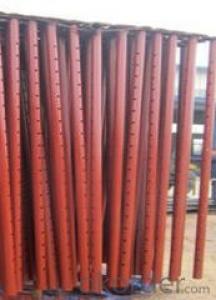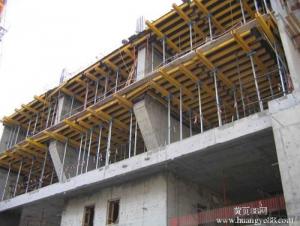Scaffolding Used Steel Props
- Loading Port:
- China Main Port
- Payment Terms:
- TT OR LC
- Min Order Qty:
- -
- Supply Capability:
- -
OKorder Service Pledge
OKorder Financial Service
You Might Also Like
Quick Details
| Type: | Scaffolding Part Type: | Material: | |||
| Surface Finish: | Adjustable Range: | Packing: | |||
| Payment Terms: |
Packaging & Delivery
| Packaging Detail: | In pallet, In bulks or as you like |
| Delivery Detail: | with 20 days after confirming the order |
Specifications
steel props
1.material: q235
2.type:light medium heavy duty prop, flower/cross/U base plate prop
3.surface: painted/gal
Scaffolding Used Steel prop
Product Description
1. Material: Q235 or Q255 or Q345
2. Surface Finish: painted, powder coated, zinc-plated, hot dip galvanization
3. Specification: light-duty, heavy-duty, U base type, cross type, italy type, american type, spanish type
4. Sizes:
5. Inspection: by ourselves or by SGS or B.V or others
6. Certificates: ISO9001, EN74, BS1139
7. Packing: inpallets
8. OEM service as avaliable
9. Samples we can offer
- Q: How do you dismantle a steel prop after use?
- To dismantle a steel prop after use, start by removing any attached accessories or attachments. Then, loosen any adjustable parts or mechanisms and collapse the prop into its smallest form. Finally, carefully disassemble the remaining sections, using appropriate tools if necessary, until all parts are separated and ready for storage or disposal.
- Q: Are steel props adjustable under load?
- No, steel props are not adjustable under load.
- Q: Are steel props compatible with different types of temporary signage or advertising displays?
- Yes, steel props are compatible with different types of temporary signage or advertising displays. Steel props are often used to provide support and stability to signage and displays, regardless of the material or design. They are versatile and can be adjusted to accommodate various sizes and heights of signage, making them suitable for a wide range of temporary advertising needs. Additionally, steel props are strong and durable, ensuring that the signage or display remains securely in place, even in outdoor or high-traffic environments.
- Q: Can steel props be used for supporting temporary seating arrangements?
- Yes, steel props can be used for supporting temporary seating arrangements. Steel props are commonly used in construction for providing temporary support, and their adjustable height and strength make them suitable for supporting various structures, including temporary seating arrangements.
- Q: Steel support, mixed soil support, calculation method?
- There are many kinds of support, you said, according to the points of the material as well as the credits,
- Q: What are the common safety certifications or standards for steel props?
- Steel props must meet certain safety criteria and be of high quality to be used in construction projects. To ensure this, there are several safety certifications and standards that steel props must adhere to. Here are some examples: 1. Adjustable steel props used in construction must comply with EN 1065, a European standard. This standard covers load-bearing capacity, dimensional tolerances, and material specifications. 2. In the UK, the design, testing, and use of adjustable steel props are governed by BS 4074. This standard includes requirements for load capacity, stability, and safe working practices. 3. ANSI/ASSE A10.9 is an American National Standard that sets safety requirements for temporary shoring systems, including steel props. It covers capacity, design, installation, inspection, and maintenance. 4. OSHA regulations in the US establish safety standards for various aspects of construction, including temporary support systems like steel props. Compliance with these regulations is essential to ensure the props meet the necessary safety requirements. 5. ISO 9001 is an international standard that focuses on quality management systems. Although it does not specifically address safety, compliance with ISO 9001 ensures that the manufacturer of steel props follows strict quality control processes, thus ensuring overall quality and reliability. It is important to note that these are just a few examples of safety certifications and standards for steel props. Depending on the country and specific project requirements, there may be additional regional or industry-specific certifications to consider. Consulting with local authorities, construction professionals, and manufacturers is always recommended to ensure compliance with relevant safety certifications and standards in a particular region or project.
- Q: How are steel props installed?
- Steel props, which are also referred to as telescopic props or acrow props, are commonly utilized in construction for the purpose of supporting temporary structures or providing additional support to existing structures. The process of installing steel props involves several steps: 1. Preparation: It is of utmost importance to evaluate the load-bearing requirements and specific needs of the construction project prior to installing steel props. This entails determining the height and spacing of the props, as well as selecting the appropriate prop size and capacity. 2. Positioning: Once the props are prepared, they must be positioned accurately. This entails placing the base plate on a stable and level surface, ensuring its ability to bear the load. The base plates should be positioned perpendicular to the load-bearing surface to guarantee stability. 3. Length adjustment: Steel props are typically adjustable in terms of height to accommodate different construction requirements. To adjust the length of the prop, the inner tube is extended or retracted by rotating the outer tube. It is crucial to ensure that the prop is securely locked in place at the desired length to prevent any movement during construction. 4. Securing: Once the desired length is achieved, the prop must be firmly secured in place. This is often accomplished by utilizing a locking pin, clip, or bolt that fits into pre-drilled holes in the outer tube. The locking mechanism should be tightened adequately to prevent any movement or slippage during construction. 5. Load distribution: In cases where multiple props are employed, it is essential to evenly distribute the load among them. This aids in ensuring stability and preventing excessive stress on individual props. Load distribution can be achieved by utilizing suitable timber or steel beams to transfer the load from the structure to the props. 6. Regular inspection: After installation, it is crucial to regularly inspect the steel props to ensure their ongoing stability and safety. This involves checking for any indications of wear, damage, or movement. Any props that are damaged or compromised should be immediately replaced to avoid potential accidents. In conclusion, the installation of steel props necessitates meticulous planning, accurate positioning, and secure fastening to ensure their effectiveness in supporting construction projects. Adhering to proper installation procedures and conducting regular inspections are vital for maintaining a secure and stable construction environment.
- Q: Can steel props be used for temporary support in sewage treatment plant construction?
- Steel props are a viable option for temporary support in the construction of sewage treatment plants. They are commonly utilized in construction projects to provide temporary support to structures during construction or renovation work. With their adjustability and easy installation, steel props are well-suited for a variety of applications, including sewage treatment plant construction. By offering stability and strength, steel props can effectively support the weight of temporary structures like formwork or scaffolding throughout the construction process. Their adjustable nature allows them to be set at the required height, and they have the capacity to withstand heavy loads, making them ideal for supporting the various components and equipment used in sewage treatment plant construction. Furthermore, steel props exhibit durability and resistance to environmental factors such as moisture and corrosion, rendering them suitable for the demanding conditions found in sewage treatment plants. They can endure the harsh conditions, including exposure to chemicals and high humidity levels, commonly present in these facilities. In conclusion, steel props are a dependable and versatile solution for temporary support in sewage treatment plant construction. They possess the necessary strength, adjustability, and durability to meet the demands of such projects.
- Q: What are the common safety training requirements for using steel props?
- The common safety training requirements for using steel props include: 1. Proper handling techniques: Training should cover how to safely lift, carry, and transport steel props to prevent strain and injuries. This includes understanding the weight limits and using proper lifting equipment when necessary. 2. Inspection and maintenance: Workers should be trained on how to inspect steel props for any signs of damage or deterioration before use. This includes checking for cracks, bends, rust, or any other defects that might compromise the prop's structural integrity. 3. Setting up and dismantling procedures: Proper training should be provided on how to correctly assemble and disassemble steel props. This includes understanding the correct sequence of components and ensuring that all connections are secure. 4. Load capacity and weight distribution: Workers need to be educated on the maximum load capacity of steel props and how to distribute weight evenly to prevent overloading or instability. This knowledge is crucial for maintaining a safe working environment. 5. Stability and bracing: Training should cover the importance of providing adequate stability and bracing for steel props. Workers need to understand how to properly secure props to prevent accidental collapse or movement during use. 6. Personal protective equipment (PPE): Safety training should include the requirement to wear appropriate PPE, such as hard hats, safety goggles, gloves, and steel-toed boots, when working with steel props. 7. Emergency procedures: Workers should be trained on the appropriate emergency procedures in case of accidents or incidents involving steel props. This includes knowing how to safely evacuate the area and how to provide basic first aid if necessary. Overall, safety training for using steel props should focus on promoting awareness, proper handling techniques, and adherence to safety guidelines to minimize the risk of accidents and injuries in the workplace.
- Q: How do you ensure proper bracing of steel props?
- To ensure proper bracing of steel props, it is important to follow a few key steps. Firstly, it is crucial to assess the load and determine the appropriate number and size of steel props required to support the structure. This can be done by considering factors such as the weight of the structure, the height of the props, and the distance between them. Next, it is important to properly position the steel props to evenly distribute the load. The props should be placed at regular intervals and aligned vertically with the load-bearing members they are supporting. It is advisable to consult structural engineering calculations or drawings to ensure accurate placement. Once the props are in position, they should be securely braced to provide stability and prevent any lateral movement. This can be achieved by using diagonal bracing, which involves connecting the props to adjacent structural elements using appropriate connectors such as steel plates, bolts, or clamps. The bracing should be installed at various heights along the props to provide maximum support. Additionally, it is essential to regularly inspect the bracing system to ensure its integrity. This includes checking for any signs of damage, such as loose connections or bent components, and promptly addressing any issues that may compromise the stability of the steel props. Overall, ensuring proper bracing of steel props involves careful planning, accurate positioning, secure bracing, and regular inspection to maintain the stability and safety of the structure.
Send your message to us
Scaffolding Used Steel Props
- Loading Port:
- China Main Port
- Payment Terms:
- TT OR LC
- Min Order Qty:
- -
- Supply Capability:
- -
OKorder Service Pledge
OKorder Financial Service
Similar products
Hot products
Hot Searches
Related keywords
























